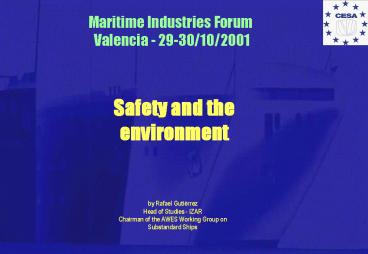Safety and the environment - PowerPoint PPT Presentation
1 / 16
Title:
Safety and the environment
Description:
Leading cruise ship technology. TBT-free paints. Leading ferry technology. Biological waste ... Ships designed and built to the standards of two decades ago are ... – PowerPoint PPT presentation
Number of Views:50
Avg rating:3.0/5.0
Title: Safety and the environment
1
Safety and the environment
Maritime Industries Forum Valencia -
29-30/10/2001
- by Rafael Gutiérrez
- Head of Studies - IZAR
- Chairman of the AWES Working Group on Substandard
Ships
2
Safety Environmental Protection derive from
three factors
THE SEAS
Safety Environmental Protection
MEN
SHIPS
3
Shoreside support has contributed to safety
- Navigation aids and charts (GPS, ECDIS)
- Vessel Traffic Separation
- Ship-to-shore communications (GMDSS, Inmarsat,
ECDIS) - Search and Rescue
- Weather forecast and reporting
4
Regulations are better and better enforced
- SOLAS 74 came into force in 1981
- Marpol 73/78 came into force in 1982
- STCW came into force in 1984
- The Paris Memorandum on Port State Control was
signed in 1982 - Constant updates of these regulations have raised
the safety environmental standards in response
to social pressures - Great stress has been put by port states and
class societies on the enforcement of existing
regulations
5
And better ships make safer seas !
- Ship designs are safer than ever (design tools
permit a better match to actual perils of the
sea) - Shipbuilding quality in the best yards is higher
than ever - Marine equipment today is better than ever
SHIPS ARE BETTER THAN EVER ! TECHNOLOGY COUNTS !!
6
Leading cruise ship technology
Environmentally friendly refrigerants
Refrigerant loog book
Means to recover refrigerants in case of
accidental release
Waste management
Low-NOx engines
Low SOx fuels
Ballast water management plan
Incinerator
TBT-free paints
Enhanced bilge water system
Holding tanks for black grey water
Double hull protecting fuel lube oil tanks
7
Leading ferry technology
Helicopter Landing Area
TV surveillance system with 48 cameras
Optimised hull form to reduce fuel consumption
Marine Evacuation System (MES)
Diesel-electric engine concept running on Marine
Diesel Oil to reduce SOX NOX emissions
2 bow thrusters for added manoeuvrability
Biological waste and sewage treatment
TBT-free anti-fouling paint
8
Leading tanker technology
Redundant propulsion (2 shaft lines engines in
independent engine rooms)
VOC recovered burned in main engines
Extra cargo tank subdivision (lower spill VOC)
Controllable pitch propellers (added
maneuverability)
Reinforced main hull structure
Redundant steering (2 high lift rudders)
2 bow thrusters for added maneuverability
Double hull exceeding minimum MARPOL 13F
dimensions
Double hull protecting fuel oil tanks
9
Marine transportation is very safe
- The worlds ships move every year over 6 times
more Tons-Km than all the EUs road freight
vehicles - Yet they cause 5 times less average annual loss
of life - Marine transport is over 30 times safer than
roads - ...and can be made still better
Source Lloyds EU DG Transport (1992-96)
10
Ship losses and marine pollution have decreased
steadily since the 1980s
Number of spills over 700 tons SOURCE ITOPF
11
But... Europe still has problems with tankers
BRAER
BALTIC CARRIER
SEA EMPRESS
IEVOLI SUN
ERIKA
KRISTAL
BALU
AEGEAN SEA
HAVEN
AGIP ABRUZZO
VOLGONEFT 248
ARAGON
NASSIA
CASTOR
KHARK V
12
... and ferrys
SLEIPNER
ESTONIA
SCANDINAVIAN STAR
and bulkers and fishing ships etc.
HERALD OF FREE ENTERPRISE
MOBY PRINCE
EXPRESS SAMINA
13
Port state control enforcement has gained
momentum since the 1980s
PARIS MEMORANDUM Over the past 12 months a total
of 18,526 ships have been inspected. During
10,755 (58.1) of these inspections one or more
deficiencies where found and 1,813 (9.8)
inspections resulted in a detention (The Paris
Memorandum website - October 2001)
14
The worlds fleet age has a negative impact on
casualty rates
Current situation (fleet age 15-19 yrs) Loss
rate 0.3 - 0,4
New fleet (fleet age 0-4 yrs) Loss rate lt 0.05
Source IUA Marine Report Statistics 1999
15
Social demands will impose increasing safety
environmental burdens on marine operations
- Safety and environmental standards are not
absolute. They are set by social expectations
that will rise with time. - Ships designed and built to the standards of two
decades ago are not necessarily acceptable today. - Consideration must also be given to periodically
upgrading existing ships. - The recent compromise for the accelerated
elimination of single hull tankers is a good
example. - Fleet renewal will be a major challenge in the
next decade, but it has many advantages. - New ships are safer because they are new, but
also because they incorporate the newest safety
and environmental technologies, often well ahead
of international regulations requirements.
16
The safety and environmental challenge
- Safety and environmental protection are becoming
competitive tools in all economic sectors in the
worlds most developed markets the US, the EU,
Japan, etc. This will eventually become obvious
also for the maritime industries. - Far from an inconvenience and a sunken cost, the
emphasis in safety and the environment will be a
major tool of survival and growth in coming
decades, under the impulse of growing social
demands. - The European maritime industries and
administrations should capitalise their
technological potential and take up the challenge
to answer these demands, contributing to a more
sustainable economic and social development in
Europe.































